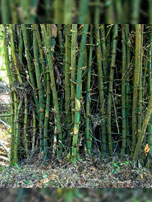SHAHEED KARTAR SINGH SARABHA AYURVEDIC MEDICAL COLLEGE & HOSPITAL
Affiliated to Guru Ravidas Ayurved University, Hoshiarpur Punjab
Affiliated to Guru Ravidas Ayurved University, Hoshiarpur Punjab

Botanical Name : Bambusa bambos (L.) Voss.
Family : Gramineae; Poaceae.
Introduction:
Latin name : Bambusa = Indian name; bambos = derived froro the name bamboo’.
Bamboo, common name for about 45 genera and about 480 species of perennial, woody, usually shrubby or treelike plants of the grass family. Bamboos occur mostly in tropical and subtropical areas, from sea level to snow-capped mountain peaks, with a few species reaching into temperate areas. They are most abundant in southeastern Asia, with some species in the Americas and Africa and none in Australia. The plants range from stiff reeds about 1 m (about 3 ft) tall to giants reaching 50 m (164 ft) in height and 30 cm (12 in) in diameter near the base. Most bamboos are erect, but some are viny, producing impenetrable thickets in some areas.
stamens, and two stigmas typical of most grasses. In addition, although many bamboos flower annually, many others flower only at intervals of 10 to 100 years. All members of a particular species flower at the same time, and the plants die shortly after flowering and setting their seed. The individual species are perpetuated by the seed or by new culms sprouted from rhizomes.
Bamboos are among the plants most widely used by humans. In the tropics they are used for constructing houses, rafts, bridges, and scaffolding. Split and flattened culms can be used as flooring and interwoven to make baskets, mats, hats, fish traps, and other articles; culms of large species may be used as containers for liquids. Paper is made from bamboo pulp, and fishing rods, water pipes, musical instruments, and chopsticks from other parts. Many bamboos are planted as ornamentals, and young shoots are eaten as a vegetable. The grain is also a food.
Names in different Indian languages :
English: Spiny Bamboo, Thorny Bamboo
Hindi : Bams, kantabams
Kannada : Bedru
Malayalam : Mula, illi
Sanskrit: Vansha, venuh
Tamil : Moongil, Moongiluppu
Telugu : Vedurubiyyam, veduruppu
Unani : Qasab, Tabaashir
Synonyms :
Vansha, Venu, Kichaka, Trinadhwaj, Shatparvaa, Yavphala. Vanshalochana, Vansharochanaa, Shubhaa, tugaa, Tugaakshiri, Tvakkshiri
Bambusa arundinaceae (Retz.) Roxb.
Arundo bambos L.
Classification according to Charaka, Susrutha & Vagbhata :
Charaka
Susrutha
Vagbhata
Varieties & adulterants – (CV – controversy, AD – adulterants) :
Substitute
Maranta arundinacea Linn
Curcuma angustifolia Roxb
Morphology :
In female variety of bamboo, white juice gets accumulated in its hollow cavity, which is called as ‘Vanshalochan’(bamboo manna). This tree grows 15-20 mtrs. high usually on islands. Stem – circumference is 30-40 cms. with distant nodes and the cavity between two nodes is hollow.
Leaves – long with tapering ends; flowers and Fruits – occur after 30 yrs. flower stalk – long and branched.
Flowers – homosexual. Fruit – resembles yava fruit and known as Vanshayav. It bears flowers and fruits in summer.
Distribution & Habitat :
All over India, hut mainly in Assam, Brahmadesh. Java and Sumatra
Chemical constituents :
Vanshalochan (Ayurveda) contains 90% silica. potash, calciun carbonate, aluminium and yeast. (Artificial vanshalochan is available in the market which is not useful.)
taxiphyllin
Properties :
Plant
Rasa : madhur, kashaya:
Guna : ruksha, laghu, Tiksna;
Virya : sheeta but tender leaves and fruits – ushna.
Vipaka -katu
Karma :
Vasti sodanam, chedayam, sopha haram
Vanshalochan
Rasa-Kasäya, madhur
Guna-ruksha
Virya- sheeta
Vipaka-madhura
Balyam, vrisyam, grahi, dadhuvardati, vrana hara
Bamboo Grains
Rasa : madhur, kashaya:
Guna : ruksha
Virya : sheeta
Vipaka -madhura
Balyam, pushtim, pittaharam
Root – kaphapittashamak. tender leaves and fruits – pittavardhak, vanshalochan – vatapittashamak
carminative, digestive,astingent,bitter, aphrodisiac, decreses lipid cholestrol level, blood purifier, antipyretic, ,antimicrobial, antifungal, anthelmintic, antiviral, anti-inflammatory, antifertility, hypoglycaemic
Indication :
Raktapittam, daham, trishna, vranam, mutrakrichram, kushtam, pandu, swasa, kasa
fever, skin disease, cough, piles, leucorrhoea,vomiting, dysentery,gout, burning sensation,dyspepsia,cephalgia, worm infection
Part used :
Vanshalochan , root, leaves
Dosage :
Vanshalochan 1-2 gm
Decoctions – 15 to 100 ml
Uses :
Paste or ash of the roots is used locally in skin disorders. ringworm infection and dermatoses. Vanshalochan is used in vomiting, diarrhoea, heart disease, bleeding disorders. cough, asthma, chronic fever, general debility. Decoction of leaves is useful is dysmenorrhoea and ammenorrhoea.
Fruit acts on meda dhatu and is useful in fat metabolism and obesity Decoction of roots is given in rabies.
Important Yogas or Formations :
Sitopaladi churna, Talisadi churna.
